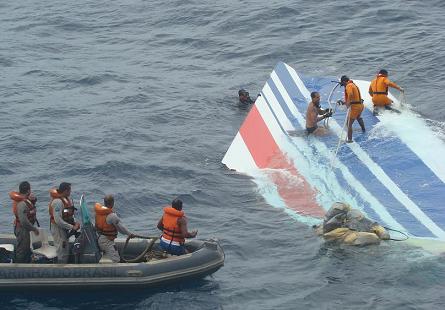Data transmitted from the Air France Airbus A330 that crashed into the South Atlantic has given French accident investigators some insight into a range of aircraft system faults, but no information about the nature of its trajectory during its descent into the sea or its structural integrity. The aircraft crashed en route from Rio de Janeiro to Paris on 1 June with the loss of 216 passengers and 12 crew
Some debris has been retrieved from the surface, but efforts to find AF447 - and the flight data recorder that will be the key to establishing the cause of the crash - are hindered by the great sea depth in the crash region, of up to 6,000m (19,700ft).
BEA investigations agency director Paul-Louis Arslanian has cautioned the international media about the value of the error signals transmitted automatically by the aircraft (see box), stating that they were "not designed for investigations" and only gave an indication as to the status of particular systems without providing information about why the systems status had changed.
 |
|---|
Arslanian says that while a connection between the signals and the loss of flight AF447 "would appear probable", there was no direct evidence of "causality between the messages and the accident".
A330 ACARS data provides symptoms not cause Between 02:10 and 02:14 GMT AF447's aircraft communications addressing and reporting system (ACARS) reported five failure reports and 19 warnings; including some repeats.
|
The region in which the aircraft disappeared, the inter-tropical convergence zone, is characterised by cumulonimbus cloud and thunderstorms caused by vigorous convective activity generated by surface heating. Meteo France deputy director Alain Ratier, however, says the weather systems on 1 June were "normal" for the tropics: "We cannot conclude that this situation was exceptional."
A systems anomaly, the details of which were datalinked to Air France, would have given the crew a very high workload shortly before the aircraft's loss. A disparity developed between the information provided by the aircraft's three pitot-static systems. This would have provided the crew with different, possibly fluctuating, airspeed and altitude indications and, at the same time, it caused the autopilot and autothrottle to trip out, leaving the pilots to fly the aircraft manually.
The problem is believed to have been caused by the pitot tubes becoming corrupted by ice and/or water, because the probes installed on this airframe were of a model that had a record of such problems in bad weather. Air France is currently replacing them with an improved model that has more effective water drainage.
Meanwhile, Airbus has reissued a bulletin originally promulgated in 2001 about the procedure for dealing with this situation, which consists of maintaining a combination of aircraft attitude and power that is known to keep the airspeed within an acceptable range.
The fact that the aircraft was lost within minutes of this problem arising makes the circumstances strikingly similar to previous accidents in which a system failure or anomaly distracted the pilots, following which the aircraft entered a rapid descent that the crew failed to arrest.
These accidents, which all took place over sea at night, include the 1996 Birgenair Boeing 757 pitot-static corruption incident in which false airspeed indications led to a stall warning and loss of control, the 2004 Flash Airlines 737-300 loss over the Red Sea and the 2007 Adam Air 737-400 loss of control over the Java Sea when the crew fixated on troubleshooting a failed system.
Source: Flight International



















